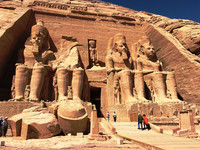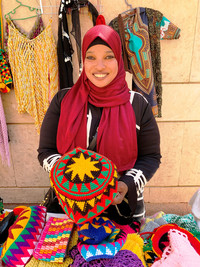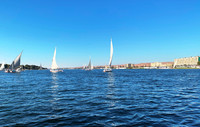By Glenda Winders
All I knew about Aswan before I visited Egypt was that it had a dam, and that much is certainly true. But there is so much else there to discover that by the time we left my husband and I had decided it was our favorite Egyptian city.
The Aswan High Dam is without doubt the place to begin exploring since its construction has had such an impact on local life and culture. Our guide, Sameh Samir, remembers when his father was one of the 30,000 engineers and other workers on the round-the-clock operation that lasted for 11 years.
Made up of 17 times more granite than was used in the Great Pyramid, it is the largest embankment dam in the world. It created Lake Nasser — one of the largest lakes in the world — which extends into Sudan, where it is known as Lake Nubia.
When the dam opened in 1970 it provided water for irrigation, controlled flooding, improved traffic on the Nile and doubled the amount of electricity available to Egyptians — but at a price. Where the lake was created had once been the ancestral home of the Nubians, who now had to be relocated.
These are a people descended from an ancient civilization thought to be as old as Egypt itself. The men are largely fishermen and sailors, and the women are artisans who craft pieces to sell. They speak a language of their own that is neither written nor taught. They are known to be honest, big-hearted people who find security in cooperative ownership.
We first met some of them when they were crew members on our felucca. This is a traditional wooden sailboat that provides a way to experience the Nile that is largely tranquil — except for the cheerful boys who paddled up to ours in small rowboats and sang with such pure, melodious voices that we were happy to pay the tips for which they were hoping.
Midway through our felucca ride a crew member whipped the covering off a large table at the front of the boat, revealing handmade Nubian jewelry and sandalwood ankhs that we flocked forward to see and buy. Back at the pier others had laid out brightly hued pieces of art and clothing. Some of the men were playing "Happy Birthday" on stringed instruments called rababas.
Later we learned how self-sufficient Nubians are when we had dinner in the home of Ahmed Gahlan and his family. They had grown everything on our plates — from tomatoes, eggplants, cucumbers, okra and garlic to the chicken that was our meat. Gahlan's sister had made our cheese after she milked a water buffalo.
Gahlan demonstrated how he makes baskets out of fronds from the palm tree in the front yard. His family uses the baskets for shopping and laundry, then feeds them to their goats when they are worn out.
While we had been out on the water we passed the Old Cataract Hotel, a leftover from British colonial times, where the likes of Winston Churchill, Jimmy Carter, Princess Diana and Egypt's own King Farouk have stayed. It was here that Agatha Christie, who was married to an Egyptologist, was inspired to write "Death on the Nile."
Our tour group operator had chosen to put us up at the nearby Movenpick Resort on Elephantine Island, which required that we shuttle to the mainland by boat, also great fun. From here we were able to visit several other Aswan attractions, including the Unfinished Obelisk at the oldest quarry in Egypt. The pharaoh Akhenaten believed obelisks to be petrified rays of the sun god Ra's light, and this one would have been a third larger than any other in existence, weighing 1,700 tons on its completion. Unfortunately it cracked before it could be extricated and so remains here for visitors to see in its still partially buried state.
We also stopped at a shop that sold Egyptian cotton. While tourism is Egypt's main source of income, cotton is one of the primary components of its economy. The fibers are especially long and soft, creating high-quality fabrics for everything from tablecloths and wall hangings to shirts and scarves. This was a good place to purchase gifts to take home since the items were easy to pack.
The most significant of our outings was to Abu Simbel, three hours away by bus or a short flight. This is where Ramses II built a temple in his own honor. It had been buried in sand for centuries and was only rediscovered in 1813.
The massive structure is guarded by four huge statues of Ramses on the outside with smaller statues of his wives at his feet and baboons to greet the sun along the frieze. The temple was engineered so that sunbeams would reach far inside to a figure of him on the dates of his birth and coronation. A nearby temple built for his wife was the first to be erected for a woman.
Knowing that the temples would have been submerged when Lake Nasser was filled, UNESCO partnered with the Egyptian Department of Antiquities and some 52 contributing countries to cut them apart and rebuild them on higher ground to save them — an engineering marvel and yet another consequence of the Aswan High Dam.
WHEN YOU GO
In order to see and learn about everything Egypt has to offer, a guide is an absolute must. Google "tours of Egypt" and you'll find many at several different price points. We decided on Smithsonian Journeys and recommend them highly: www.smithsonianjourneys.org.



Glenda Winders is a freelance writer. To read features by other Creators Syndicate writers and cartoonists, visit the Creators Syndicate website at www.creators.com.
Traditional wooden sailboats called "feluccas" provide a peaceful way to ply the waters of the Nile River in Aswan, Egypt. Photo courtesy of Phil Allen.






View Comments